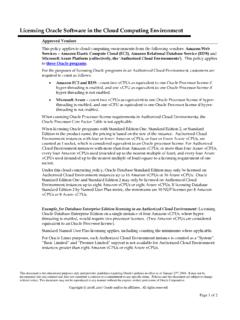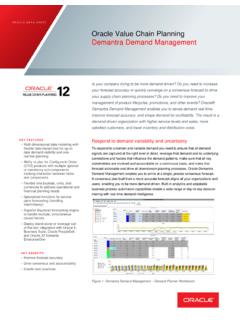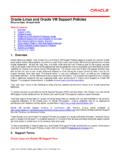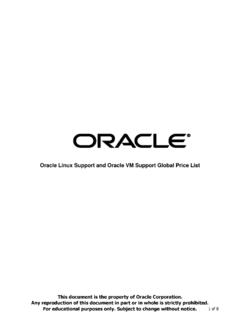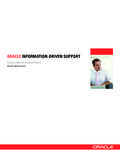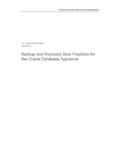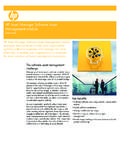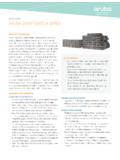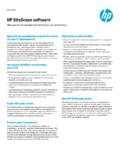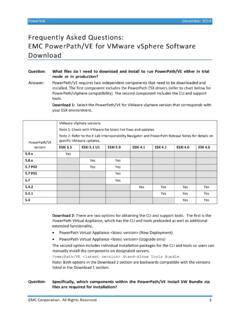Transcription of Best Practices for Migrating SAP Environments - …
1 An oracle White Paper April 2010 Best Practices for Migrating SAP Environments oracle White Paper Best Practices for Migrating SAP Environments Introduction .. 3 Overview .. 4 Migration Considerations .. 4 The Migration Process .. 5 Challenges and Concerns .. 6 Leverage oracle Services .. 6 Next Steps .. 7 Assessing Resources and Requirements .. 7 Evaluating the Source System .. 8 Architecting the Target System .. 8 Assessing Human Resources .. 8 Determining Toolkit/Media/License Resources .. 9 Next Steps .. 10 Creating the Plan .. 10 Writing the Plan .. 10 Next Steps .. 11 Preparing the Infrastructure .. 11 Setting Expectations.
2 11 Obtaining Resources .. 12 Preparing the Source System .. 12 Preparing the Target System .. 13 Creating the Checklists .. 13 Next Steps .. 15 Performing the Migration .. 15 Optimizing the environment .. 15 Reducing the Downtime Window .. 17 Reducing Contention .. 18 Exporting the Database .. 18 Importing the Database .. 19 Next Steps .. 20 oracle White Paper Best Practices for Migrating SAP Environments Validating the Migration .. 20 Summary .. 21 About the Author .. 21 References .. 22 oracle White Paper Best Practices for Migrating SAP Environments 3 Introduction Migrating an SAP database and application environment , along with the associated system software and unbundled products, is one of the most demanding tasks an IT team can encounter.
3 This white paper explains the process of moving an SAP environment from one system to another, and describes the resources and services available from oracle to assist users planning a migration. In general, there are two types of migration: homogeneous and heterogeneous. A homogeneous migration is a migration from one platform and database architecture to the same platform and database. This article focuses on the more challenging type of migration heterogeneous. This type of migration consists of moving from a non- oracle platform to an oracle Sun environment , or from one database architecture to a different database architecture, or both at the same time.
4 In describing the details involved with performing a heterogeneous migration, this paper addresses the following topics: Challenges and issues Assessing requirements and resources Creating a plan Preparing the infrastructure Performing the migration Validating the migration The white paper describes procedures, techniques, and recommendations that can simplify and expedite the migration. It assumes that readers understand basic SAP technology and the services SAP provides. It also assumes they are familiar with the database software in use on both the source system (the system on which the SAP environment currently resides) and the target system (the system to which the SAP data is migrated).
5 oracle White Paper Best Practices for Migrating SAP Environments 4 Overview In today s turbulent business climate, enterprises struggle to maintain a competitive edge. To achieve an advantage, companies must be able to create innovative, high-quality products and services and quickly bring them to market. At the same time, the business must optimize profitability by improving efficiencies, increasing productivity, and driving down costs. For many companies, SAP solutions are a key factor in the ability to compete. As companies evolve, they need to respond to changes in the marketplace and within the organization.
6 Consequently, the SAP applications and IT infrastructure that support mission-critical business functions must be able to adapt more quickly to these changes than ever before. Migration Considerations As IT managers plan for the future, they must closely examine existing SAP applications and infrastructure to determine how the IT landscape can best evolve to deliver strategic new business initiatives. Obsolete technology, out-of -date applications, unmanageable growth of systems, or multiple product silos can drive the need to upgrade to a new platform. Among the many benefits of performing such an upgrade are the following: Increase utilization.
7 As servers are added to the SAP landscape to support new applications or more users, the result is often server sprawl. Managing a large number of small servers typically means greater administrative overhead and increasing maintenance costs. Consolidating the SAP environment during a platform transition can help to simplify administration, decrease licensing and administrative costs, and improve utilization, resulting in lower overall TCO. oracle s ability to consolidate and virtualize IT resources offers greater flexibility and increased efficiency in managing the SAP infrastructure. Upgrade technology. Often, the expected savings on maintenance and administration fees through the use of more efficient systems can help justify anticipated capital expenditures and provide a quick ROI.
8 Furthermore, oracle s commitment to ecoconscious computing with new processors that require significantly less power and cooling while delivering high throughput can also help to reduce operational costs. Enhance performance. In existing SAP deployments, the underlying database can exhibit a high degree of fragmentation that might adversely impact performance. A benefit of a platform migration is that, during the data transfer process, the existing database can be redesigned and tables can be re-indexed. This fine tuning helps improve the overall performance of the SAP environment . Expand capacity. Over time, many enterprises require greater capacity in their SAP infrastructure.
9 In some cases, corporate mergers, acquisitions, and new business partnerships drive this need. In others, strategic initiatives such as addressing new regulatory requirements, adding new application capabilities, and increasing data acquisition drive the need. A transition to scalable Sun systems from oracle adds the ability to grow capacity, helping enable future expansion. oracle White Paper Best Practices for Migrating SAP Environments 5 The Migration Process In the migration process (Figure 1) data is exported from the source system, which is left untouched, and then transferred to the target oracle Sun system.
10 Since the migration freezes the source system in its original state, access to SAP applications can be restored using the source system if for some reason a problem is encountered during the migration process. In this way, the source system acts as a safety net in the event that application access cannot be properly validated on the target system. Figure 1. The migration process transfers the SAP environment from the source system to the target system. The migration team follows a precise and well-documented procedure using tools that automate data movement and reduce the risk of human error. Multiple migrations might be necessary for example, an initial data migration is often pe rformed to create a test-bed to evaluate the process.
